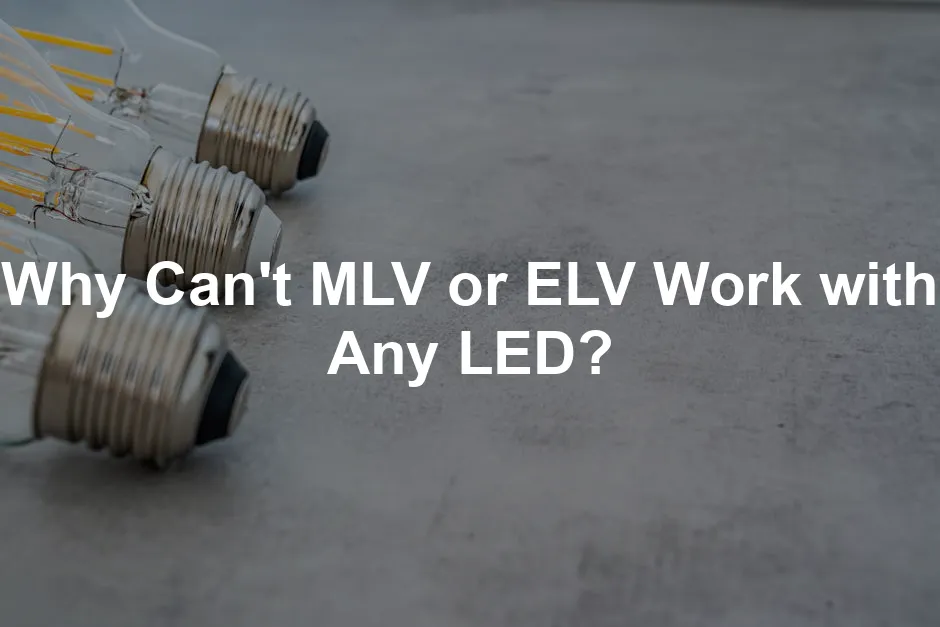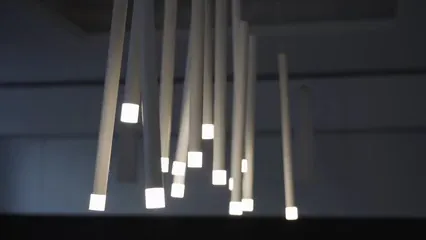
Why Can’t MLV or ELV Work with Any LED?
Introduction
Have you ever wondered why MLV (Magnetic Low Voltage) and ELV (Electronic Low Voltage) dimmers don’t work with every LED light? Understanding this compatibility is crucial for achieving the best lighting experience in your space. In this article, we aim to clarify common misconceptions surrounding MLV and ELV dimmers and their interaction with LED technology. Speaking of lighting, if you’re looking to upgrade your setup, consider the Lutron Caseta Wireless Smart Dimmer. This dimmer not only saves energy but also gives you the ability to control your lights from anywhere. Imagine dimming the lights from your couch while binge-watching your favorite series. Pure bliss!Summary and Overview
MLV and ELV dimmers are designed for specific lighting types. MLV dimmers typically power halogen and incandescent lights, while ELV dimmers serve electronic low-voltage fixtures. As LED lights gain popularity, knowing which dimmer works with them is essential for optimal performance. If you’re considering a smart lighting upgrade, check out the Philips Hue Dimmer Switch. It’s perfect for those who love to control their lighting via smartphone or voice commands. Who wouldn’t want to feel like a wizard controlling their own ambiance?
Understanding MLV and ELV Dimmers
What is MLV?
MLV stands for Magnetic Low Voltage. These dimmers use magnetic transformers to control low-voltage lighting, mainly halogen bulbs. They operate by chopping the beginning of the AC waveform to reduce brightness. Common applications include landscape lighting and track lighting with halogen bulbs. MLV dimmers are known for their durability, but they can struggle with newer LED technology. This is primarily due to differences in how the two systems manage electricity and dimming. If you’re looking to switch to LED, consider the Leviton Decora Smart Dimmer. This dimmer is known for its reliability and compatibility with various LED types.What is ELV?
Definition of Electronic Low Voltage dimmers. ELV stands for Electronic Low Voltage dimmers. These devices control low-voltage lighting by adjusting the power supplied to fixtures. They are designed to work with electronic transformers, which convert standard voltage to a lower level. Differences between ELV and MLV in terms of operation and efficiency. ELV dimmers operate using a trailing edge dimming method. This technique cuts off the end part of the AC waveform. It results in smoother dimming and less noise compared to MLV dimmers. MLV, or Magnetic Low Voltage dimmers, use magnetic transformers and typically employ leading edge dimming. This method can cause more heat and noise. Overall, ELV dimmers are more efficient and quieter than their MLV counterparts. Common applications and benefits of using ELV dimmers. ELV dimmers are widely used for track lighting, recessed lights, and landscape lighting. They provide smooth dimming capabilities, enhancing the ambiance of any space. Additionally, they are more energy-efficient, helping to lower electricity bills while extending the lifespan of bulbs. For a great LED option, consider the Philips Hue White LED Smart Bulb. It’s perfect for those who want to control their lighting with style.
Why MLV and ELV May Not Work with All LEDs
Technological Differences
MLV and ELV dimmers function differently than LED technology. MLV dimmers regulate power using magnetic transformers, while ELV dimmers rely on electronic transformers. LEDs require a constant current for optimal performance. If the dimmer doesn’t provide this, LED lights may flicker or fail to operate correctly. Understanding these fundamental differences is crucial for effective lighting. Current regulation is vital for LEDs. Unlike traditional bulbs, which can handle varying voltage, LEDs need a stable current. MLV and ELV dimmers are often not designed to meet these needs, leading to compatibility issues. To avoid such issues, investing in a quality product like the GE Reveal LED Light Bulbs can provide you with the vibrant lighting you need for any space.Load Requirements
MLV and ELV dimmers have minimum load requirements. These requirements can be a challenge when using LED lights. Many LED bulbs draw less power than traditional incandescent bulbs. This low power draw can lead to flickering or, in some cases, complete failure to operate. If the load is below the dimmer’s minimum threshold, it may not work as intended. This is particularly common with LED retrofits. Users may find that their bright LED bulbs don’t dim properly or even turn on at all. Understanding load requirements helps in selecting the right dimmer for your LEDs. In addition, consider using Sylvania LED Light Bulbs for reliable performance.Dimming Functionality
Not all dimmers work well with LEDs. Dimmable and non-dimmable LEDs require specific dimmers. If you use the wrong combination, flickering or inconsistent brightness can occur. Non-dimmable LEDs will fail with dimmers, leaving you with a frustrating experience. Improper dimming affects LED performance. It can lead to overheating, shortened lifespan, or even failure. This makes selecting the right dimmer essential for both functionality and longevity. A great option for dimming is the TP-Link Kasa Smart Dimmer Switch, which works perfectly with various LED types.
Electrical Characteristics
MLV and ELV dimmers have distinct electrical characteristics. MLV dimmers use magnetic transformers, while ELV dimmers utilize electronic transformers. These transformers handle voltage differently, which can create compatibility issues with LED drivers. LED drivers need constant current, but MLV and ELV dimmers do not always provide this. If the dimmer’s output fluctuates, it can harm the LED’s performance. Understanding these electrical properties can prevent headaches down the line. If you’re looking for a reliable LED solution, consider the Cree LED Light Bulbs for their quality and longevity.
Effects of Voltage Spikes
Voltage spikes from MLV dimmers can damage sensitive LED components. When you adjust the brightness, these spikes can surge through the system. This causes overheating, which may lead to performance issues like flickering or complete failure. For instance, a voltage spike can burn out the LED chip or affect its color rendering. This not only impacts the light quality but can also lead to costly replacements. Protecting your LEDs from these spikes is crucial for reliable performance. To ensure you have the best lighting, consider the AmazonBasics LED Bulbs that are designed for longevity and efficiency.
Choosing Compatible Dimmers for LEDs
Best Practices for Selecting Dimmers
To choose the right dimmer for your LEDs, start by checking specifications. Look for compatibility ratings on both dimmers and LED products. Ensure the dimmer supports your specific LED type—dimmable or non-dimmable. Additionally, consider the wattage and load requirements. Selecting a dimmer that matches the LED load will enhance performance. Following these guidelines will help you achieve optimal lighting results. And for those who want a sophisticated touch, the Ring Video Doorbell Pro 2 can also be a great addition to your smart home setup.
Recommendations for Compatible Products
When selecting dimmers for your LED lights, compatibility is key. Here are a few recommended dimmers known to work well with LEDs:- Lutron Caseta Wireless Smart Dimmer: This versatile dimmer operates smoothly with a wide range of LED bulbs.
- Leviton Decora Smart Dimmer: Known for its reliability, this dimmer supports both MLV and ELV.
- Philips Hue Dimmer Switch: Perfect for smart lighting setups, it integrates seamlessly with LED systems.

Conclusion
Understanding the compatibility between MLV, ELV dimmers, and LEDs is vital for achieving optimal lighting performance. MLV and ELV serve specific purposes and have unique characteristics that affect their interaction with LED technology. Choosing the right dimmer can prevent issues like flickering and can extend the lifespan of your lights. Do your research and select dimmers that match your LED specifications. This will enhance your lighting experience and ensure a pleasant ambiance in your space. And if you’re looking for a way to enjoy your favorite shows, don’t forget to grab the Fire TV Stick 4K with Alexa Voice Remote to take your entertainment to the next level.
FAQs
What types of LEDs are compatible with MLV and ELV dimmers?
LEDs designed for MLV systems typically include those that can handle higher loads, like MR16 bulbs. These are often used in conjunction with magnetic transformers. On the other hand, ELV-compatible LEDs include those with built-in drivers that can handle lower loads, making them ideal for track and recessed lighting. Always check compatibility ratings to avoid issues.
Can I use a regular LED bulb with an MLV or ELV dimmer?
Using a standard LED bulb with MLV or ELV dimmers requires careful consideration. Not all LEDs are designed to work with these dimmers. Regular LED bulbs often don’t meet the minimum load requirements of MLV and ELV systems. If the load is too low, the dimmer may not function correctly. This can lead to flickering or even complete failure of the light. Additionally, some LED bulbs are non-dimmable. If you connect these to a dimmer, expect issues. Always check the bulb’s specifications to ensure compatibility. Look for LED bulbs specifically labeled as dimmable. This simple step can save you from headaches later.
How can I tell if my dimmer is MLV or ELV?
Identifying whether your dimmer is MLV or ELV isn’t too tricky. Start by examining the dimmer’s rating label. MLV dimmers typically have higher wattage ratings and are bulkier. They often operate with magnetic transformers. In contrast, ELV dimmers are lighter and more compact, suitable for electronic transformers. Another way to tell is by checking if the dimmer has a neutral wire connection. ELV dimmers usually require a neutral wire, while MLV dimmers do not. If you’re uncertain, consult the manufacturer’s documentation for additional clarity.
What are the signs of incompatible dimmers and LEDs?
Several signs indicate incompatibility between your dimmer and LED lights. Flickering is the most common issue. If your lights flicker, it often means the dimmer is not compatible with the LED bulb. You might also hear buzzing or humming noises. This noise typically occurs when the dimmer struggles to regulate the power. Another sign is if the lights don’t dim smoothly. If you experience abrupt changes in brightness or the lights flicker during dimming, you likely have a mismatch. Identifying these signs early can help you avoid further problems.
Where can I find compatible dimmers for my LED lights?
Finding compatible dimmers for your LED lights can be simple. Start by visiting local home improvement stores. Retailers like Home Depot and Lowe’s often stock a variety of dimmers. Look for brands known for compatibility, such as Lutron or Leviton. Online platforms like Amazon also offer extensive selections. Ensure you read product descriptions carefully. Check user reviews for insights on compatibility with LED lights. Manufacturer websites often provide lists of compatible products too.
Is it worth upgrading to a compatible dimmer?
Upgrading to a compatible dimmer is generally a smart move. A proper dimmer enhances energy efficiency and improves lighting quality. With the right dimmer, you can enjoy smoother dimming and eliminate flickering issues. Additionally, compatible dimmers can extend the lifespan of your LED bulbs. By reducing the stress on the bulbs, you help them last longer. Overall, the benefits of upgrading outweigh the initial investment, making it a worthwhile consideration.
How can I troubleshoot dimming issues with my LEDs?
Troubleshooting dimming issues with your LEDs can often be straightforward. First, check your bulbs. Ensure they are dimmable and compatible with the dimmer. If you notice flickering, try replacing the bulbs with ones known to work well with your dimmer. Next, check the dimmer settings. Ensure it is properly configured for your specific LEDs. If problems persist, consider consulting the dimmer’s manual for troubleshooting tips. Lastly, if you’re still having issues, contacting a licensed electrician might be necessary to assess the situation.
All images from Pexels




